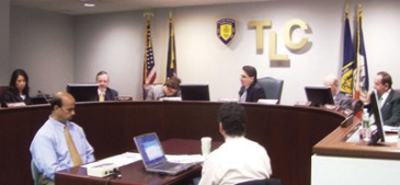 COMMISSIONER’S LETTER COMMISSIONER’S LETTER
Picture
it. An unusually cool, crisp morning on October 1, 1907. The new Plaza
Hotel rises from the ashes of the original Plaza, which was built at
the turn of the century only to be razed in 1906 to make way for its
successor.
As
guests made their way to the lobby, and Alfred Vanderbilt signed the
first signature in the guest register, they first passed by the taxi
stand in front of the hotel and its line of shiny red French taxicabs
stationed there by taxi pioneer Harry Allen. It would be at this historic
place and time that the very first pick up of a passenger by a traditional,
metered gasoline powered taxicab (a word actually coined by Allen) would
take place.
I
could point to any number of ways in which we have celebrated this milestone
over the last few months – the amazing Taxi ’07 exhibition
at the Jacob Javits Center, lighting the Empire State Building yellow,
the Garden in Transit project, etc. – but there is no question
in my mind that the most significant of these is the “Taxi of
Tomorrow” project.
It
is through the “Taxi of Tomorrow” project that we will see
the quintessential, purpose-built taxicab designed, developed and taken
from concept to drawing board to assembly line in a way that serves
everyone. In other words, this is a “wish list” vehicle
that will be clean, fueled to leave only the lightest of carbon footprints,
fully accessible to persons who use wheelchairs, aesthetically complementary
to its surroundings, economical, roomy and iconic in the way that only
a New York City yellow medallion taxicab can be.
But
before we can perfect the vehicle there are ways that we can enhance
service that never before existed. Just over a month ago, the TLC auctioned
a deeply discounted 63 of 150 additional medallion licenses specifically
earmarked for use on wheelchair accessible vehicles which will join
the 80 already on the road .
Next
spring, the final 87 will be auctioned, true to Mayor Bloomberg’s
vision, as it was he that accomplished the passage of special City and
State legislation to make these new wheelchair accessible taxicabs possible.
What better way to celebrate the taxicab’s Centennial than to
field the nation’s largest fleet of accessible vehicles.

The
New York City Taxi and Limousine Commission (TLC) voted unanimously
to approve a regulation requiring that, beginning October 1, 2008, all
taxicabs coming into service (with the exception of accessible taxicabs)
must be capable of achieving a city mileage rating of 25 miles per gallon
(mpg). This regulation also provides that, one year later, as of October
2009, all new taxicabs vehicles must have a minimum city driving rating
of 30 mpg.
Now
that we have issued the medallion licenses the challenge is to make
sure that the resources we have are maximized to the hilt. They will
serve the people who want and need their service in the most convenient
and spontaneous way possible.
I
am pleased to report that at this past month’s public commission
meeting the Board of Commissioners voted to approve a “demonstration
program” that will create an “accessible dispatch system”
in 2008 that will provide accessible taxicab and for-hire service to
wheelchair users throughout the five boroughs on request.
The
company implementing this project – the Executive Transportation
Group – is one of the acknowledged leaders in the field of professional,
computer coordinated dispatch, and is well versed in the provision of
quality customer service. Participating drivers will receive appropriate
training to serve persons using wheelchairs. Best of all, passengers
who use wheelchairs and other roll in mobility aids will be able to
access this service simply by calling 311, the government services hotline
number.
While
there were many differences of opinion at the November Commission meeting
leading up to passage of the rules creating and governing the accessible
dispatch system, it was heartening to see “all stakeholders –
including passengers” discussing and debating how to best deliver
enhanced service.
In
response to the concerns of passengers, it was made clear that the demonstration
project is intended to “bridge the gap” to a fully accessible
taxicab fleet via the Taxi of Tomorrow project. With regard to the use
of “only accessible taxicabs” to take these dispatch calls,
it was important to remind and reassure the industry that there is no
plan or intent to alter the longstanding and sufficient for-hire ground
transportation paradigm. Yellow cabs – including accessible taxicabs
– will continue to pick up street hails and use meters, and every
other non-accessible for-hire vehicle will not.
While
this new service offers more transportation options to persons who use
wheelchairs, it is doing more than merely helping people get from point
A to point B……it will answer important questions about passenger
demand for such service. It is a pilot program that could be in place
for up to two (2) years if successful – if not concluded sooner
- and every aspect of the project will be closely monitored.
Before
closing I would like to take a moment to thank our partners in this
project, including Commissioner Matthew Sapolin of the Mayor’s
Office for People with Disabilities, the Mayor’s Office of Operations,
the Department of Information Technology and Telecommunications, and
the many dedicated disability advocates with whom we have consulted.
I
would also like to thank Harry N. Allen for inspiring a century of taxicab
service that is as well known for its traditions as for its ability
to evolve to suit the needs of its passengers. A young 20-something
entrepreneur when he turned the taxi world on its head, he died here
in New York City at the age of 88 on June 27, 1965. Bravo and well done,
Mr. Allen, you will be fondly remembered!
Watch
the TLC web site at www.nyc.gov/taxi for updates, or
to access monthly medallion price charts.
© 2015 TLC Magazine Online, Inc. |